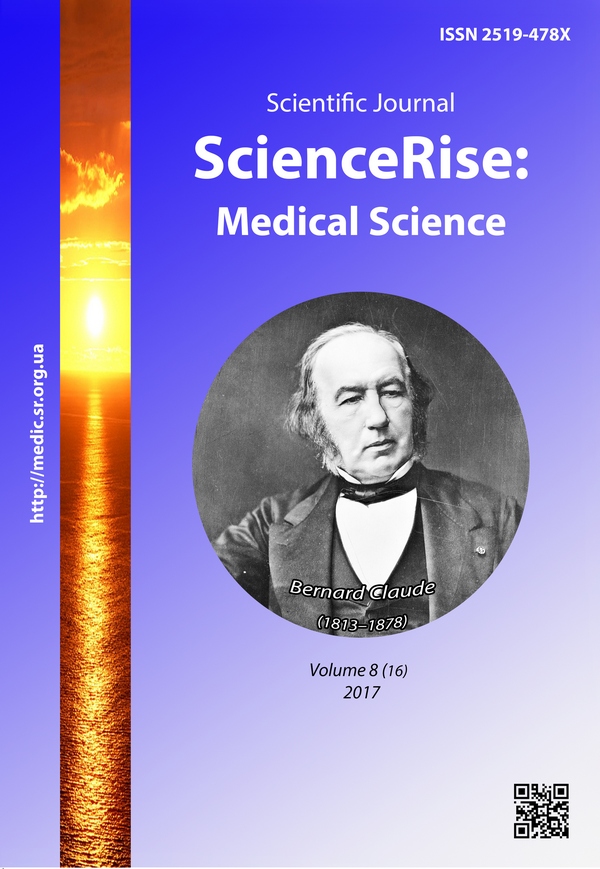The indicators of femur mineral density according to x-ray densitometry in infants
DOI:
https://doi.org/10.15587/2519-4798.2017.109299Keywords:
femur mineral density, X-ray densitometry, infantsAbstract
The aim of the research was the determination of indices of mineral density of the spongy substance, mineral density of the cortical layer and also the cortical index according to the data of X-ray densitometry in infants at norm and at hip joint dysplasia.
Materials and methods. Using the developed program „OsteoGraf-child”, there was carried out the analysis of x-ray photographs of hip joints of 56 children 0 days - 3 years old, suspected in trauma or HJD.
Results of research. „OsteoGraf-child” program for the diagnostics of structural changes of a femur at norm and at hip joint dysplasia in infants allows to determine indices of the femur mineral density, for the spongy and compact substances separately, and to calculate the cortical index.
Conclusions. Indices of the age norm of the mineral density of the spongy substance and femur cortical layer were established that allows to estimate objectively the bone tissue status in infants. At the conservative treatment of hip joint dysplasia using the long-term immobilization was detected the reliable decrease of indices of the spongy substance and cortical layer mineral density in infants of 6–12 months that needs a treatment correction
References
- Bianchi, M. L., Baim, S., Bishop, N. J., Gordon, C. M., Hans, D. B., Langman, C. B. et. al. (2009). Official positions of the International Society for Clinical Densitometry (ISCD) on DXA evaluation in children and adolescents. Pediatric Nephrology, 25 (1), 37–47. doi: 10.1007/s00467-009-1249-z
- Malinin, V. L. (2003). Sravnenie mineral'noy plotnosti kostnoy tkani poyasnichnyh pozvonkov peterburzhcev i amerikancev. Sankt-Peterburg, 184.
- Crabtree, N. J., Arabi, A., Bachrach, L. K., Fewtrell, M., El-Hajj Fuleihan, G., Kecskemethy, H. H. et. al. (2014). Dual-Energy X-Ray Absorptiometry Interpretation and Reporting in Children and Adolescents: The Revised 2013 ISCD Pediatric Official Positions. Journal of Clinical Densitometry, 17 (2), 225–242. doi: 10.1016/j.jocd.2014.01.003
- Kech, N. R. (2010). Densitometriya kak sovremennyy metod diagnostiki i opredeleniya effektivnosti lecheniya ekoobuslovlennoy patologii kostnoy sistemy u detey. Perinatologii i Pediatriya, 1 (41), 168–170.
- Sharmazanova, E. P. (2004). Strukturno-funkcional'noe sostoyanie kostnoy tkani u detey s travmaticheskimi povrezhdeniyami oporno-dvigatel'noy sistemy po dannym luchevyh metodov issledovaniya. Kyiv, 334.
- Averianova, L. O. (2003). Metod kompiuternoi renthenomorfometrii metakarpalnykh kistok liudyny u diahnostytsi. Kharkiv, 20.
- Bishop, N. J., King, F. J., Lucas, A. (1993). Increased bone mineral content of preterm infants fed with a nutrient enriched formula after discharge from hospital. Archives of Disease in Childhood, 68 (5 Spec No), 573–578. doi: 10.1136/adc.68.5_spec_no.573
- Pochkaylo, A. S. et. al. (2011). Diagnostika i lechenie deficita kostnoy massy i osteoporoza u detey. Minsk, 56.
- Povorozniuk, V. V. (2014). Zakhvoriuvannia kistkovo-miazovoi systemy v liudei riznoho viku (vybrani lektsii, ohliady, statti). Vol. 4. Kyiv, 672.
- Todyka, Yu. I. (2009). Osteoporoz u ditei: diahnostyka. Ohliad literatury (chastyna 1). Sovremennaya pediatriya, 2, 171–176.
- Danilov, R. K. (Ed.) (2010). Rukovodstvo po gistologii. Vol. 1. Sankt-Peterburg: SpecLit, 262.
- Sherepo, K. M. (2010). Mineral'noe nasyshchenie diafiza bedrennoy kosti posle endoprotezirovaniya tazobedrennogo sustava. Medicinskaya tekhnika, 1, 28–31.
- Krutikova, N. Yu. (2012). Vozrastnye osobennosti kostnoy prochnosti u novorozhdennyh, detey rannego i doshkol'nogo vozrasta (faktory riska, diagnostika, profilaktika, korrekciya narusheniy). Moscow, 226.
Downloads
Published
How to Cite
Issue
Section
License
Copyright (c) 2017 Lyliya Аveryanova, Olena Sharmazanova, Tetiana Arsenіdze

This work is licensed under a Creative Commons Attribution 4.0 International License.
Our journal abides by the Creative Commons CC BY copyright rights and permissions for open access journals.
Authors, who are published in this journal, agree to the following conditions:
1. The authors reserve the right to authorship of the work and pass the first publication right of this work to the journal under the terms of a Creative Commons CC BY, which allows others to freely distribute the published research with the obligatory reference to the authors of the original work and the first publication of the work in this journal.
2. The authors have the right to conclude separate supplement agreements that relate to non-exclusive work distribution in the form in which it has been published by the journal (for example, to upload the work to the online storage of the journal or publish it as part of a monograph), provided that the reference to the first publication of the work in this journal is included.









